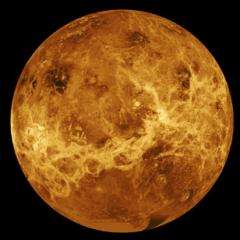May 31, 2010 report
A new theory to explain superrotation on Venus

(PhysOrg.com) -- One of the mysteries in our Solar System is superrotation, a phenomenon known since the late 1960s, in which the winds on Venus blow faster than the planet rotates. Scientists have proposed a number of theories, but none have been completely satisfactory. Now scientists in Mexico have for the first time suggested a viable mechanism by which a faster wind higher above the planet is driving the superrotation.
A complete rotation of the planet Venus takes 243 Earth days, but the atmosphere, traveling at speeds of around 200 meters per second, takes only four Earth days to go all the way around. The only other place in the Solar System in which atmospheric superrotation is common is on Saturn’s moon Titan.
Scientists from the Universidad Nacional Autonoma de Mexico, led by Héctor Javier Durand-Manterola, have been studying the supersonic-speed winds in the ionosphere 150-800 kilometers above the surface. The winds, known as the “transterminator” flow, travel at several kilometers per second. They were discovered in the 1980s by the American Pioneer Venus Orbiter, and are thought to be driven by interaction with the solar wind.
Durand-Manterola and his team propose that the transterminator flow in the cryosphere could transfer flow momentum to the atmosphere below in the form of pressure waves as they dissipate. They propose the interaction on the night side between the flow on the dawn side and the flow on the dusk side generates waves because they flow at different speeds, with the dusk side flow being much faster.
The waves travel down from the ionosphere, and through the thermosphere and mesosphere to the troposphere depositing most of the momentum and dissipating in the cloud layer, moving the atmosphere in a retrograde direction and driving the superrotation.
The team calculated the energy flow that transports the transterminator flow and compared it to the calculated energy lost by the atmosphere’s viscosity. These calculations showed there is enough energy in the transterminator flow to overcome the viscosity and drive superrotation. They then calculated the amplitude the waves would need to have to induce superrotation and found the required amplitude would produce 84 dB on the night side, enough to maintain a roar in the clouds on the planet’s night side “similar to a symphony orchestra playing 'fortissimo'.”
The researchers tested their theories of energy transfer in an experiment using water. They directed a jet of water onto one side of a sheet of polystyrene from a height of 0.2 m, which created a flow radiating outwards at 2 m/s. They directed a second jet of water onto the other side of the sheet, this time from 0.02 m, and this created a radial flow of 0.63 m/s. Turbulence occurred in the area where the two flows interacted and superficial waves were observed moving from the faster flow to the slower flow, which demonstrated that in this analog the momentum of the waves travels in the predicted direction.
The Akatsuki extraterrestrial weather satellite, which was launched from Japan last Friday, should arrive at Venus in December, when it may shed some light on the issue.
More information: Superrotation on Venus: Driven By Waves Generated By Dissipation of the Transterminator Flow, arxiv.org/abs/1005.3488
© 2010 PhysOrg.com




















